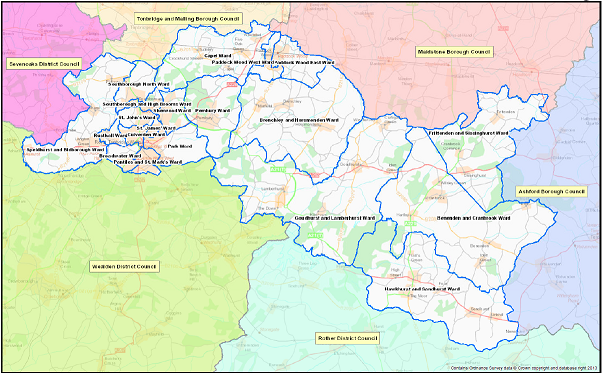Number of Councillors
Contents
Tunbridge Wells Borough Council currently has 48 Councillors who are each elected for a four-year term. The Borough area is divided into 20 roughly equal 'wards'. The Councillors are elected to, and represent, their local ward.
The Borough area (represented by the blue lines below) runs from Speldhurst and Bidborough in the West, to Hawkhurst and Sandhurst and Frittenden and Sissinghurst in the East, with the main settlements being Royal Tunbridge Wells, Southborough, Paddock Wood, Cranbrook and Hawkhurst.
There are 14 Parish Councils and two Town Councils within the Borough area with separate Parish and Town Councillors representing these administrative bodies.
The Borough area lies within the County of Kent which is administered by Kent County Council. Within the Borough area there are six County Councillors who represent the views of the Borough at Kent County Council meetings (held in Maidstone).
There are also two Members of Parliament who represent the Borough area.
This consultation relates specifically to Tunbridge Wells Borough Councillors only.
The Borough Council is considering how many Borough Councillors it should have in the future. There are currently 48 Borough Councillors in 20 wards. Some wards have only one Borough Councillor to represent them (such as Capel), whilst others have up to three (such as Pembury). More information on Borough Councillors and wards can be found on the Councillors and Wards section of our website.
Ward map

Elector ratio
Each local authority has an elector ratio, which is determined by the number of electors in an area, divided by the number of councillors. The elector ratio (based on the 2020 register of electors) for the Borough is 1,769. This means that on average, each Borough Councillor is responsible for 1,769 electors.
The table below compares this ratio with a group of 14 other authorities of a similar size and type to Tunbridge Wells Borough Council (our CIPFA Nearest Neighbours grouping).
| Authority | Electorate | Wards | Councillors | Elector ratio |
|---|---|---|---|---|
| Basingstoke and Deane | 136,809 | 18 | 54 | 2,534 |
| Warwick | 109,025 | 17 | 44 | 2,478 |
| Broxbourne | 72,667 | 10 | 30 | 2,422 |
| Chelmsford | 135,909 | 24 | 57 | 2,384 |
| Cherwell | 112,645 | 16 | 48 | 2,347 |
| Maidstone | 127,013 | 26 | 55 | 2,309 |
| Test Valley | 98,538 | 20 | 43 | 2,292 |
| Dacorum | 113,191 | 25 | 51 | 2,219 |
| Mid Sussex | 114,159 | 26 | 54 | 2,114 |
| North Hertfordshire | 101,791 | 24 | 49 | 2,077 |
| Ashford | 97,342 | 39 | 47 | 2,071 |
| Hertsmere | 77,106 | 16 | 39 | 1,977 |
| Rugby | 80,584 | 16 | 42 | 1,919 |
| Tonbridge and Malling | 98,280 | 24 | 54 | 1,820 |
| Tunbridge Wells | 84,917 | 20 | 48 | 1,769 |
The role of a Borough Councillor
Borough Councillors are responsible for a range of different tasks and functions.
Ward work
Primarily they are responsible for representing the views of the people in the ward in which they are elected to. They also assist residents in their area with a variety of issues that can include problems with benefits payments, informal (non-professional) advice and guidance around planning applications, and signposting to a range of other authorities and organisations with specialist help available (such as adult social care or mental health support provision). This work is known as ward work and is an important part of being a Councillor.
Council meetings
Alongside their ward work, Borough Councillors attend a range of meetings at the Borough Council to make decisions on policies, plans and projects, and individual applications. The Borough Council has 12 main public meetings where the public may attend and decisions are made. In 2019-20 there were 92 meetings held, with Councillors attending on average 17 meetings per year (the actual figure varies between Councillors depending on their responsibilities. The range is from 6 – 33 per year). Public meetings are largely held in the evenings starting at 6pm or 6.30pm.
Borough Councillors also attend a range of informal or non-public meetings with officers to discuss issues and plans in depth before they come to public meetings for decisions. These meetings tend to be held during the day.
Partnerships
Borough Councillors also work with a range of other organisations that seek to improve the lives of the residents of the Borough, such as charities and trusts. These organisations are known as ‘outside bodies’, and Councillors can be nominated to their main committees to help oversee the work of the body. The Borough Council formally appoints Councillors to 14 outside bodies, but individual councillors may offer their skills and experience to a range of other organisations outside of the immediate purview of the Council.
The Borough Council also has a formal relationship with the Royal Tunbridge Wells Town Forum and our Town and Parish Councils, and Borough Councillors attend the meetings of these bodies to ensure there is representation from the Borough Council.
Allowances
Borough Councillors receive a small allowance for the role they perform which is expected to cover the costs of any additional IT equipment, and the additional costs for printing, phone calls, and utilities for the work that they do for the Borough.
Most Borough Councillors receive a maximum of £5,500 a year. Mileage and any training expenses can be claimed separately. More information on allowances and expenses can be found on the Councillor allowances and expenses page of our website.